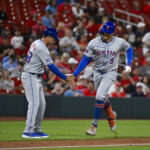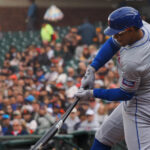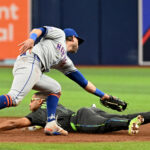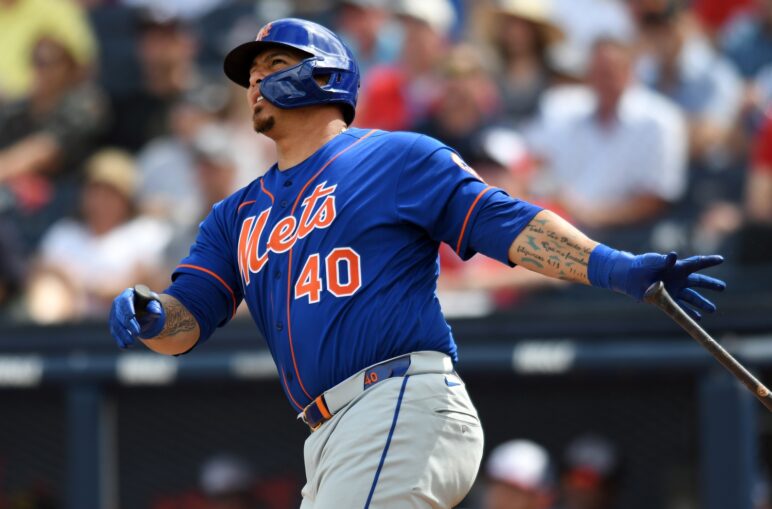
Catcher may be one of the more curious positions for a big league baseball team to try filling, given all the directions executives and coaches can take.
You can make a straightforward shot at adding offense to a lineup, though you can also leverage the position into a benefit for your pitchers by going with an elite framer. It’s nearly impossible to find a backstop that can offer both, and having a second (or even third) in-command that can reasonably mirror whatever production you get from your starter is arguably just as important.
It’s a long season – even with a month and a half being shaved off due to the coronavirus pandemic. Depth matters, especially at the most demanding of positions. Fortunately, each team in the NL East seems to be doing things a bit differently from one another. Let’s gather a bit about them with this set of rankings, starting at the bottom:
5. Miami Marlins
Aiding in the development of a young pitching staff looks to be the primary focus in the Marlins’ assortment of backstops. 26-year old and former Philadelphia prospect Jorge Alfaro, even with the slow learning curve of pitch framing, seems remotely capable of holding down the fort in an everyday role. Until he can cut down on the strikeouts, however, he’s really as much of a project as some of these Miami arms.
The setup behind Alfaro appears to serve the pitching-first initiative pretty clearly, though. Francisco Cervelli, despite the offensive withering that has marked a transition away from a starting role, could be of reasonable assistance as an occasional replacement and regular clubhouse cog. Chad Wallach and Ryan Lavarnway are relying on those same factors that have kept Bryan Holaday, A.J. Ellis, and several other replacement-level Miami backstops in business over the years.
Unfortunately for the Marlins, these sorts of projects translate to far more learning than winning. Unless Alfaro can figure out an identity with either the stick or the glove, there’s almost nothing to expect here.
4. New York Mets
The Mets get credit for coming away with something two offseasons ago when they were spurned by Yasmani Grandal and still managed to sign the next-best option in Wilson Ramos. In terms of the latter’s numbers last year (.767 OPS and 105 wRC+), the organization certainly got all the offensive output it had ordered.
Unfortunately for New York, defense behind the plate is just as important, if not more – as Grandal’s value has continued to show the last few years. In this department, Ramos falls brutally short. His inability to frame bore consequences for the entire pitching staff, and the club didn’t bother adding any glove-first depth to offset Tomas Nido‘s sluggish bat.
Take into account the fact that Ramos turns 33 in August and had appeared in over 130 games just once in his career prior to 2019, the Mets’ entire value from behind the dish hinges on one aging bat doing enough to cover his tracks as a poor defender. They’re about three years away from rising prospect Francisco Alvarez and one injury away from personal catcher Rene Rivera garnering regular reps.
3. Washington Nationals
A lot like they did around the infield, the defending World Champion Nationals aren’t so set on having one formidable player behind the dish as they are on having a handful of above-replacement-level options at their disposal. 36-year old Kurt Suzuki can definitely swing it with the other seven hitters on the lineup card, and 33-year old Yan Gomes brings a bit extra to the table with the glove.
Washington can also call up and squeeze a respectable two to three weeks out of Welington Castillo if the situation calls for it, though he’s pretty much a designated hitter at this stage in his career.
After 2020, though, the arrangement gets a lot bleaker. One of Raudy Read or Tres Barrera could evolve into a quality backup option with another year, though the future behind the plate for Washington is almost certainly waiting in the 2021 free-agent class. The Nats’ catcher-by-committee blueprint turned out some pleasant results in 2019, but it’s definitely on its last legs.
2. Philadelphia Phillies
Having the best catcher in the division, if not the entire National League, in J.T. Realmuto will certainly take you places. With FanGraphs projecting a 4.4 WAR for him in 2020, Realmuto is more-or-less in a class of his own. Making the 66th percentile in framing and 100th percentile in pop time should be enough to guarantee a payday this coming offseason.
Behind Realmuto, the Phillies have a passable backup in Andrew Knapp, who turned -10 DRS in 2018 into a neutral zero in 2019. But Knapp also failed to log 300 innings, and his .642 OPS puts the onus squarely on continuing to improve in the field.
A lot like the Mets, the Phillies lack the depth behind their two active catchers. Deivy Grullon, who notched 21 homers for a second straight year in Triple-A Lehigh Valley, would be the next call. With nine big-league plate appearances to his name, the 24-year old probably only sees action in either the unlikely event Realmuto misses significant time or the more likely event Knapp struggles.
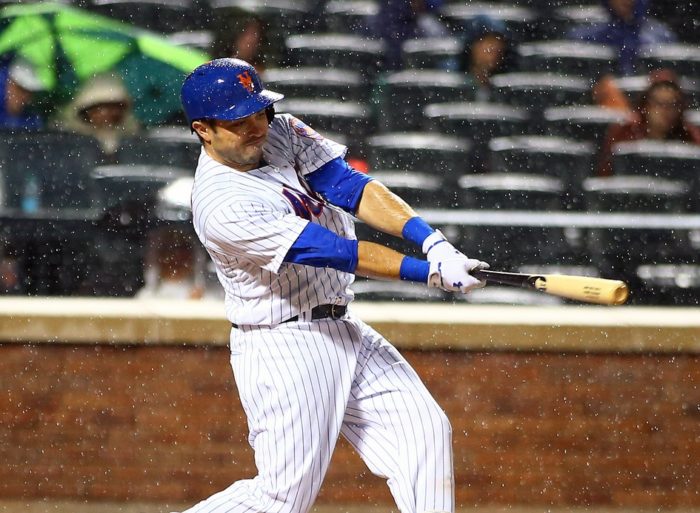
1. Atlanta Braves
Philadelphia may have the golden goose in Realmuto, but Atlanta’s commitment to two above-average catchers in Travis d’Arnaud and Tyler Flowers is a lot safer across a full season.
D’Arnaud and Flowers, at 31 and 34, respectively, grade out more promisingly than Washington’s duo of Suzuki and Gomes, particularly in defensive terms. Flowers’ 13 runs-extra strikes tied Grandal for the second-highest in all of baseball last year behind Austin Hedges, and d’Arnaud’s offensive renaissance in Tampa Bay made him one of the more attractive second-tier free agents.
What’s more, the Braves still have three catching prospects to look forward to in Shea Langeliers, William Contreras, and Alex Jackson, the former two of whom rank in the organizational top ten (per MLB Pipeline) and the latter of whom would be next in line on the depth chart.
Either veteran is capable of sliding in for the other in the event of injury, even if you take the under on them as hitters. The Braves’ lineup prioritizes offensive production pretty heavily, though they have done a solid job tabbing defenders to the positions that matter most (see Ender Inciarte in center field, Dansby Swanson at shortstop, Ozzie Albies at second base).





